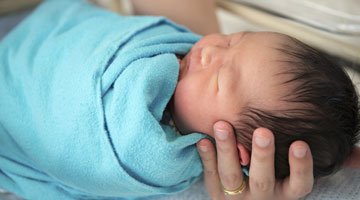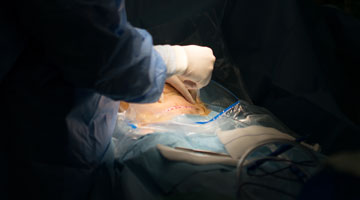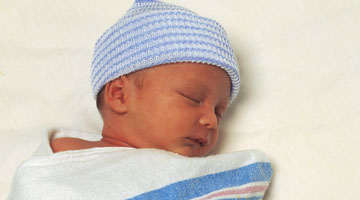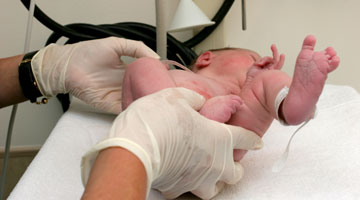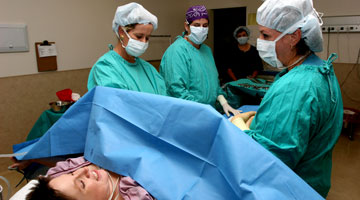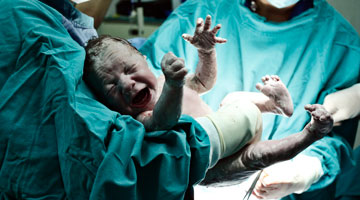C-Sections and V-BACs
Everything You Need To know About C-Sections (Cesarean Section)
A cesarean section, commonly referred to as a c-section, is the delivery of a newborn through a surgical incision in the woman’s abdomen and uterus as opposed to going through the birth canal, naturally. According to the CDC, the cesarean delivery rate in 2014 was 32.2% of all births. Over a million cesarean sections were performed and although the percentage growth has slowed down somewhat over the last few years, it's much higher than historical levels and it has CDC concerned. Some researchers even claim that half of the c-sections performed in the United States could have been safe vaginal deliveries. Percentage also varies greatly by hospitals, so it's good idea to do your research before deciding where to give birth, as the biggest risk factor of having a c-section might just be the hospital you pick.
Scheduled vs. Emergency Procedure
Depending on the circumstance and advice of your doctor, c-sections can either be scheduled or unplanned procedures. There are a couple main reasons that women have planned c-sections, according
... Read more
to obstetrician and gynecologist Jay Goldberg, MD. “Anticipated c-sections are for reasons like, malpresentation. The baby is breech or it is not head down. If you have twins and one of the babies is breech, specifically the first one, your doctor is going to recommend a c-section. If you have had a prior c-section, your doctor may recommend a c-section. If you have had two prior c-sections, your doctor is most likely going to recommend a c-section.” Dr Goldberg continues by explaining reasons for unscheduled or emergency c-sections. “You’ve gone into labor and end up with a c-section. There are many reasons those can happen, distress in the baby, failure to dilate, or you can get all the way to ten centimeters, push and not be able to deliver the baby vaginally. The ultimate goal is to get the baby out in a healthy manner, so a c-section shouldn’t be a scary thing because sometimes it is necessary.” Labor dystocia, the obstruction of labor due to pelvic issues, is another reason that doctors will perform a c-section. Signs of labor arrest or abnormal fetal heart rates are other very common indications that a cesarean section is necessary to maintain the health of the mother and the baby. Other reasons for unplanned c-sections include: suspected fetal macrosomia (larger than average babies), excessive maternal weight gain, preeclampsia, twin gestation, and herpes simplex virus. Again, each circumstance can be different, so you should talk to your doctor and find out what is going to work best for you and your baby.
Pros and Cons of C- Sections
Although c-sections might sound frightening, they can truly be life-saving for both mom and baby. Electing to have a c-section can help women avoid later pelvic floor weakness or trauma. Yet, there are some risks to a c-section such as, infection, blood loss, blood clots, or injuries to other organs. Recovery and hospital stay times for mothers after a c-section can be long and painful. For women who have had multiple c-sections, there can be greater risk for later pregnancies or uterine rupture. There are also some positive attributes of having a vaginal birth. Immediate skin to skin contact for closer bonding and immediate ability to breastfeed are just some of the upsides to a non c-section birth. Also, delayed cord clamping can be beneficial for the baby by increasing levels of iron and minimizing risk of anemia or transfusions. However, American Congress of Obstetricians and Gynecologists published researcher estimating that there is no difference in the chance that urinary incontinence or postpartum depression will occur based on a vaginal delivery or c-section. Placental abnormalities can also be increased with prior c-section delivery versus vaginal delivery and risk can increase with each c-section after.
Vaginal Birth After Cesarean Section (VBAC)
Can I have a natural, vaginal birth after a c-section? VBAC indicates a successful vaginal delivery after a previous baby has been delivered by c-section. In the past, once a mother had her first c-section, for any subsequent child she would have another c-section. However, this has changed. Dr. Paul Crane, MD, a well know obstetrician, lays out the benefits and risks of VBAC, “The risk of vaginal birth after cesarean is a rupture to the uterus. That is a potentially devastating situation that can cause severe damage to the mother, and can cause death or damage to the fetus. The incident of rupture, however, is not particularly high… The advantage of VBAC is that you undergo a vaginal birth, with a much quicker recovery. You are able to nurse and take care of the new baby, and the older child.” Dr. Lauren Hyman, an accomplished OBGYN discusses more about the risks factors of a VBAC, “Well about a 3rd of babies in the United States are delivered by cesarean section and all of these mothers, if they become pregnant again are going to have to make the decision of whether to undergo a trial of labor or simply to have a repeat cesarean section. And it’s a huge thing to consider. If you end up having a successful vaginal birth after cesarean section, the recovery time can be easier and not having additional surgeries can be safer for the women… That being said, when someone attempts to have a trial of labor and is unsuccessful, then there can be a lot more complications, and then if one had a cesarean section to begin with.” She continues, “There’s a higher risk of infection, recovery time can be longer, and the recovery process can be difficult. The other thing to consider is while it’s less than 1%, the big risk of having a trial of labor after the cesarean section is rupturing the uterus along the scar line in the uterus.” As always, find an obstetrician that can help you along your journey and do what is best for you and your newborn.
C Section Recovery
C-sections require a long recovery period due to the incision made in your abdomen. Normally, a horizontal cut is made near the bikini line. Another incision will be made through the uterine wall to reach the baby. Post surgery, doctors and nurses will monitor the incision and other vitals. Breastfeeding and slight activity is encouraged as soon as possible. Scar treatments are available post-surgery. The general recovery time is about six weeks, although this depends on the circumstance.
Our Experts
To learn more about delivery methods and other important tips, visit kidsinthehouse.com or hear from our experts: Lauren D. Hyman, MD Dani Klein Modisett Jay Goldberg, MD Debi Cox Paul Crane, MD Suzanne Gilberg-Lenz, MD Shamsah Amersi, MD



